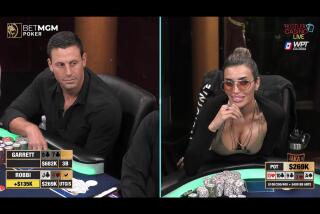Poker: Losing a bluff can still pay off
- Share via
Sometimes you have all the elements you need to pull off a bluff, but then your opponent spoils it by making a call.
It’s not a total loss, however, if you can turn a misread into some information useful later on, as top young pro Eric Baldwin found in this hand from the World Poker Tour’s $15,000-buy-in Doyle Brunson Five Diamond World Poker Classic at Las Vegas’ Bellagio in 2009. With blinds at $100-$200 plus a $25-chip ante, Baldwin raised to $575 from middle position with 6-4 offsuit.
“I had just won a pot, so I was trying to get a little rush going,” said Baldwin, the 2009 Card Player magazine Player of the Year. “I raised and got called in four spots.”
The flop came 5-3-8, two hearts, giving Baldwin an open-ended straight draw. Both blinds checked. Baldwin bet $1,000 into a pot worth $3,125.
“I just wanted to keep the lead in the pot,” said Baldwin, a pro from the Ultimatebet.net online site. “I wanted to judge by how people call me and what type of hand they might have. If I keep control of the pot, I might get the chance to bluff at the end.”
Baldwin got one caller behind him.
“There was a good chance he had a heart draw or a small pair,” Baldwin said.
The turn came the queen of diamonds.
“Based on how quickly he called on the flop, I put him on a draw,” Baldwin said. “A lot of people call right away when they have draws; they tend to ponder a little more when they have a made hand. He seemed like the type of player who could call on the turn, so I just checked to take a free card, and if the heart draw missed on the river, my plan was to bluff. He checked behind me right away. He was happy to take a free card, which reinforced my belief he was on a draw.”
The river came the 10 of clubs.
“I can’t beat anything,” Baldwin said. “I’ve got 6-high. But if he was on a heart draw, he missed. If he had an 8, then there are two overcards out there, so I’m going to fire a decent-sized bet in relation to the pot and pick it up with 6-high.”
Baldwin bet $3,775. His opponent called and showed 8-7 of spades, taking the pot with a pair of 8s.
“It was one of those spots where you feel like you’ve made a good bluff, but the other player just didn’t do what you thought he was going to do,” said Baldwin, winner of a World Series of Poker bracelet in 2009. “You can’t let yourself get discouraged. A lot of times in these tournaments, you won’t have a good read on your opponents. But now he’s a guy I wouldn’t try to bluff again if I think he has a piece of the board.”
TABLE TALK
Open-ended straight draw: Four consecutive cards to a straight that can be completed by a card on the top or bottom end.
More to Read
Go beyond the scoreboard
Get the latest on L.A.'s teams in the daily Sports Report newsletter.
You may occasionally receive promotional content from the Los Angeles Times.










